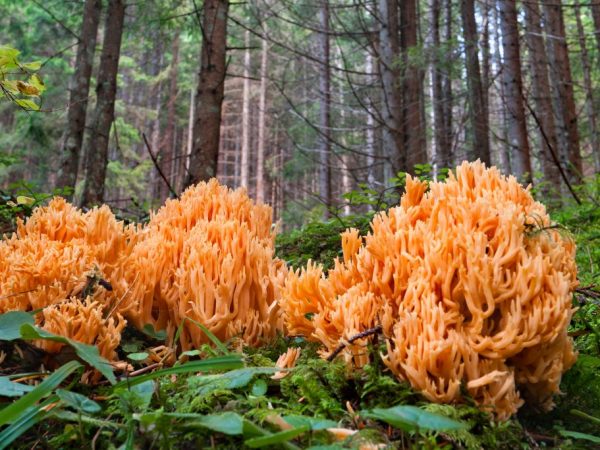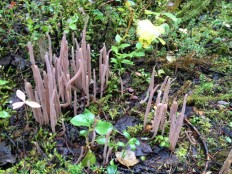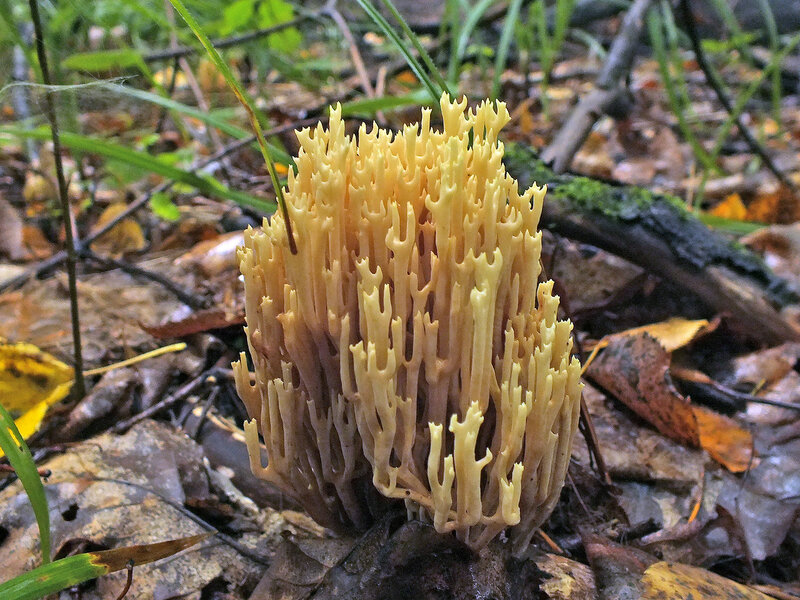Fawn horned (Clavulinopsis fawn): description and photo
| Name: | Fawn horned |
| Latin name: | Clavulinopsis helvola |
| Type of: | Inedible |
| Synonyms: | Clavulinopsis fawn |
| Specifications: |
|
| Systematics: |
|
Fawn clavulinopsis (Clavulinopsis Helvola), also called Fawn Rogatik, belongs to the large Clavariev family. The genus has more than 120 varieties. For their original appearance, they were popularly called deer horns, hedgehogs and corals. The colony of these fungi really resembles marine organisms that have settled in the forest.

Where do fawn clavulinopsis grow
Distributed throughout the Northern Hemisphere. In Russia, they are most often found in the Far East and in the western regions of the country. Usually grow in large colonies or singly on fertile soils, in moss, in half-rotted remains of trunks and branches, in forest waste. Favorite habitat - deciduous and mixed forests with an abundance of sun. Appears in August and bears fruit until mid to late September.
What do fawn slingshots look like
The fruiting body is small, strongly elongated, without a pronounced cap. It is yellow-sandy in color, uniform over the entire surface, becomes slightly lighter towards the base. Sometimes it can take on a bright carrot shade. When the fungus appears, the apex is sharp, as it grows, it becomes rounded, smoothly turns into a thin short stem, no more than 0.8-1.2 cm. The entire surface is a spore-bearing layer. It is dull, slightly rough, with weakly pronounced longitudinal grooves.
It grows from 2.5 to 5.5 cm, some specimens reach 10 cm, and the thickness ranges from 1 to 5 mm. The pulp is fragile, yellowish-beige in color, has a spongy structure, without a pronounced odor.

Is it possible to eat fawn clavulinopsis
Clavulinopsis fawn, like other representatives of its species, does not contain substances toxic to humans. However, the bitter taste and unpleasant pungent juice did not allow this species of horned to be attributed to edible mushrooms. They do not eat it, the species is inedible.
How to distinguish fawn slingshots
This type of mushroom has no poisonous counterparts. They are similar to some of the yellow and beige varieties of their own family.
- The horn is fusiform. Inedible due to peppery taste. Has a poisonous yellow color, pointed brownish tips.
- Horny horned. Refers to conditionally edible mushrooms because of the pungent juice. It differs from the fawn variety in larger sizes - up to 16 cm, clavate.
- The horned is yellow. Edible, belongs to the IV category. Reaches a height of 20 cm, differs in a bushy shape, when branched outgrowths-horns grow from one fleshy leg.
Conclusion
Fawn clavulinopsis is an unusual representative of the mushroom kingdom. He can be mistaken for a native of the sea world - his appearance is so peculiar. It grows everywhere in Eurasia and North America. Being a saprophyte, it brings tangible benefits to the forest, provides soil fertility. It is not poisonous, but it should not be eaten. The taste and culinary value of the fruiting body is extremely low.
What does a deer horn mushroom look like and how it differs from poisonous species

Antler mushrooms differ from many species in their non-standard form for mushrooms, which resembles antlers - due to this, the variety got its name. Having found such fruits in the forest, not every mushroom picker will dare to cut them, since this variety has several dangerous and poisonous counterparts, and its very appearance often causes fears among beginners in a "quiet hunt".
Description of the antler mushroom
This variety is also commonly called yellow coral slingshot, yellow coral and bear's paw. Outwardly, it resembles not only deer antlers, but also sea corals. The view does not correspond at all to the traditional ideas about mushrooms due to the absence of a cap and a leg as such.
What does a slingshot look like
The horned grows vertically (reaches 5-7 cm in height on average) and can grow up to 25 cm wide. It is distinguished by the presence of a large number of branches, thorns and brittle, fragile ears. Depending on the ripening phase, the horns can change their color: young fruits are colored in light yellow shades, more mature ones - in rich orange. Some mushrooms can be colored beige or purple.

In many countries, the mushroom is listed in the Red Book, and there are several rules for collecting it:
- you need to collect fruits only in wicker baskets, otherwise the mushrooms will turn into mush;
- at the cathedral, you need to choose only young specimens, since the old ones are more difficult to cook and unpleasant to eat (they are very bitter);
- when harvesting in hot weather, cut mushrooms should be covered with fern leaves or grass so that they do not burn in the sun;
- you need to cut off the horns at the base, without touching the roots.
In Crimea
Horns can often be found in the Crimea in coniferous and mixed forests. Its wide distribution in this area is facilitated by the mild climate and warm weather.

In the Far East
The fungus is widely distributed in the Far East, Caucasus and Karelia. Almost never found in the central part of Russia due to the peculiarities of the climate.

Varieties of edible horned horns
Edible slingshots are a real find for any mushroom picker. They are safe to eat and look similar to each other. They often grow in groups deep in coniferous forests.
Groovid
Grape-shaped (bunchy) is a porcini mushroom, which becomes light pink as it ripens. The branches can reach a height of 15-20 cm, and its diameter is 10 cm. The fruit body of older specimens is ocher or pinkish-red, often resembling cauliflower. The lower branches are few, thin and oblong.













































